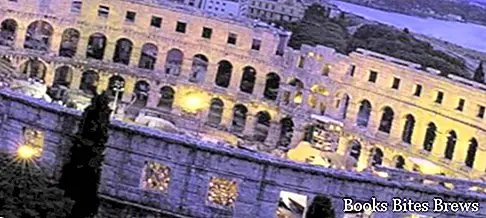What to see in Istria, attractions and places to visit on the peninsula, including Pula, Porec, where the Euphrasian Basilica, Porec, Novigrad and the Rovinj Civic Museum are located.
Tourist information
Istria is the largest peninsula in the Adriatic Sea whose territory is almost entirely included in Croatia.
A small part, including the coastal towns of Isola d'Istria (Izola), Portoroz (Portoro), Piran (Piran) and Capodistria (Koper), belongs to Slovenia, while the territories of the municipality of Muggia and San Dorligo della Valle / Dolina are located in Italian territory.
What see
Pula, located in the southern end of the Istrian peninsula, is the largest cultural, political and administrative center of the peninsula as well as a popular and popular tourist resort, thanks to its crystal clear sea and its beautiful coasts.
In Pula there are monuments of Roman architecture, including the Arena symbol of the city, built in the first century at the time of the emperor Vespasian, the Temple of Augustus, the Arch of the Sergii of the first century BC, the Hercules Gate and the Theater Roman.
Fažana is a town located about 10 kilometers from Pula, where it is possible to take the ferry to visit the Brijuni islands, an archipelago made up of 14 islands, not far from the coast, which together with the surrounding sea make up a very protected area. beautiful.
Medulin, located in the southern end of the peninsula about 8 kilometers east of Pula, is an important tourist center, located in a bay characterized by numerous inlets, rocks and islets, protected to the west by Capo Promontore and to the east by Capo Merlera or Marlera .
Porec, located on the western coast of the Istrian peninsula, thanks to its long coast and its sea, can count on a very varied tourist infrastructure, able to offer good accommodation possibilities.
The city, of Roman origins, developed around the port, protected by the islet of San Nicola.
It has a very interesting historical center, where its main monument is the Euphrasian Basilica, dating back to the fifth century and enlarged in the sixth by the bishop Euphrasius of the Byzantine Empire.
Umag, an important tourist center, is located on the north-western part of Istria, a few kilometers from Trieste.
Recommended readings- Istria: what to see in the largest Adriatic peninsula
- Meleda (Croatia): what to see on the island
- Korcula (Croatia): what to see on the island of Dalmatia
- Makarska (Croatia): what to see on the Riviera
- Bol, Supetar and Sutivan (Croatia): what to see on the island of Brac
In the ancient part of the city there is the castle, with the eighteenth century Church of Santa Maria, the Cathedral dedicated to the Assumption into Heaven of Mary and San Pellegrino, protector of the city.
Novigrad is a town located near Porec and Umag, whose name, translated into Italian, means Novigrad.
Located on a small peninsula, surrounded by the sea and beautiful nature, it can count on a rich historical and cultural heritage.
The imprint of the city is from the Venetian period.
Of the early Christian Basilica of San Pelagio, rebuilt in the 16th century, only the 11th century Romanesque crypt remains.
Rovinj is located in the western part of the Istrian peninsula between the cities of Porec in the north and Pula in the south.
A city rich in history, it shows important examples of architecture, including the Cathedral of Santa Eufemia, reachable through the steep streets of the historic center, from its bell tower it is possible to admire a splendid panorama.
The coast of Rovinj extends from Capo San Giovanni in the north to Capo Barbariga in the south, excluding the territory of the city of Rovinj, which goes from the railway level crossing to the edge of the Monte Mulini forest, including all the islands of the coastal strip , which constitute a protected natural heritage.
Rovinj has good tourist infrastructure and an interesting Civic Museum.
Vrsar is located in the western part of Istria, between Porec and Rovinj, at the mouth of the Canale di Leme, an enchanting fjord of about 12 km which enters the Istrian coast.
In the historic center of the town, surrounded by simple walls, it is possible to visit the church of Sant'Antonio da Padova, from the second half of the seventeenth century.
In front of the coast characterized by beaches, rocks and inlets, the 18 islets of the Vrsar archipelago are surrounded by greenery.
Vrsar is also visited by those who practice naturalism, as there is the largest nudist beach in Europe.
Fontana is a small village that meets when proceeding from Vrsar to Porec.
The small center is compensated by the large hotel and tourist area.
This location is also suitable for those who practice naturalism.
Rabac, which is located in the south-eastern part of Istria, is surrounded by beautiful nature, it is also considered a popular tourist resort.
Albona, located near Rabac and about 3 km from the sea, is located at an altitude of 320.
The influence of the Venetian period stands out very much by observing the architecture of this town, in particular by looking at the Cathedral, with the fifteenth century Lion of San Marco on the facade and loggia, Palazzo Lazzarini and other buildings.
Albona is suitable for those who prefer a peaceful holiday, as well as for lovers of art and culture.




